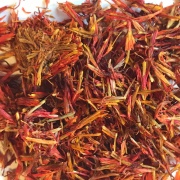Safflower (Carthamus tinctorius) LC
Description
Safflower is an annual spiny plant that can grow to 1 m high. The plant is native to the area between northern India and the Near East [1].
The petals of the safflower plant (Carthamus tinctorius L.) contain several yellow dyes, but most famous is its red dye, carthamin, which has been used as a red colorant for textiles and cosmetics, especially in Asia, for centuries. Carthamin is isolated by washing safflower petals extensively with water to remove the yellow dyes, extracting the insoluble red pigment into an alkaline solution and then precipitating the red dye itself by acidification with citric or acetic acid (e.g., from lemon juice, vinegar, etc.) Often the dye is further purified by adsorption onto cotton or other substances, from which it can be re-extracted and then used for dyeing [2].
Dyeing with carthamin is normally done at ambient temperature, and one needs to work relatively quickly as the dye in solution is not very stable. In 1997, Kim and Paik studied the stability of solutions of carthamin and found that it has a half-life at 25 °C, at pH 5 (near the pH at which dyeing is done) of only 4 h. They also found that the stability decreases at higher temperatures, with the half-life decreasing to about 4 min at 80 °C [3].
Historical Importance
Safflower has been cultivated in the eastern Mediterranean since earliest antiquity and later in southern Europe (Spain, Italy and France) and central Europe. It spread east to China along the ancient silk road around the 3rd or 4th century [1].
In the Asian tradition, safflower was usually used with a yellow dye, usually one that contains berberine, to produce a fiery red color having an orange hue [4].
Examples:
Summary of results
Sample preparation
HPLC-DAD profile of safflower dye. A sample (~0.1g) from Tanakano, Japan was extracted with 1 mL methanol: (v:v=1:1). Then the upper 30 μl of solution was removed for HPLC-DAD-MS analysis (20 μl was injected).
HPLC-DAD-MS analysis was performed with an Agilent 1100 liquid chromatography system consisting of an automatic injector, a gradient pump, a HP series 1100 DAD, and an Agilent series 1100 VL on-line atmospheric pressure ionization electrospray ionization mass spectrometer. Separations were done on a Vydac 214TP52 analytical column (2.1 mm diameterX250 mm; 5-ím particle size). The column was eluted at a flow rate of 0.2 mL/min with a tertiary gradient of water (A),acetonitrile (B), and 1% (v/v) aqueous formic acid (C) with the following elution program: 0 min, 90% A, 5% B, 5% C; 0-55 min, a linear gradient to 35% A, 60% B, 5% C; 55-60 min, a linear gradient elution to 15% A, 80% B, 5% C; 60-62 min, isocratic elution at 15% A, 80% B, 5% C; 62-70 min gradient elution to 90% A, 5% B, 5% C; and reequilibration with the latter solvent for 15 min. The mass spectrometer was run both in the negative and positive ion mode.
HPLC-DAD
[[|600px|center|Absorbance at 350nm (mAU)]]
Result
Identified compounds
References
[1] D. Cardon "Natural Dyes, Sources, Tradition, Technology and Science" 54.
[2] J. Wouters, C. Grzywacz, A. Claro, Markers for Identification of Faded Safflower (Carthamus tinctorius L.) Colorants by HPLC-PDA-MS, Studies in Conservation, 2010, 55, 186-203.
[3] J.-B. Kim and Y.-S. Paik, "Stability of carthamin fromCarthamus tinctorius in aqueous solution: pH and temperature effects", Archives of Pharmacal Research, December 1997, Volume 20, Issue 6, pp 643–646.
[4] R.A. Laursen and C. Mouri "Decomposition and analysis of carthamin in safflower-dyed textiles", e-Preservation Science 2013, 10, 35-37.
